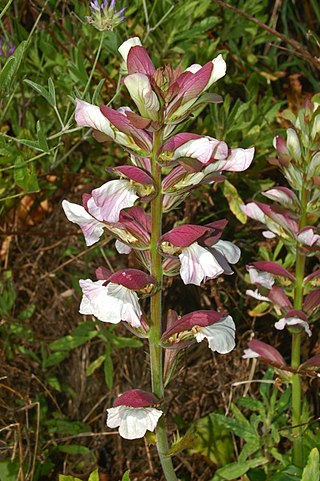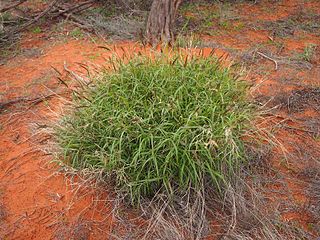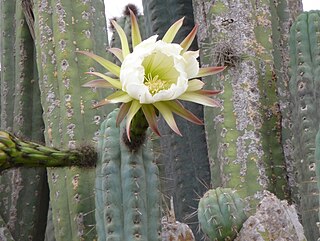
Acanthaceae is a family of dicotyledonous flowering plants containing almost 250 genera and about 2500 species. Most are tropical herbs, shrubs, or twining vines; some are epiphytes. Only a few species are distributed in temperate regions. The four main centres of distribution are Indonesia and Malaysia, Africa, Brazil, and Central America. Representatives of the family can be found in nearly every habitat, including dense or open forests, scrublands, wet fields and valleys, sea coast and marine areas, swamps, and mangrove forests.

Salix caprea, known as goat willow, pussy willow or great sallow, is a common species of willow native to Europe and western and central Asia.

Acanthus mollis, commonly known as bear's breeches, sea dock, bear's foot plant, sea holly, gator plant or oyster plant, is a species of plant in the family Acanthaceae and is native to the Mediterranean region. It is a leafy, clump-forming perennial herb, with a rosette of relatively large, lobed or toothed leaves, and purplish and white flowers on an erect spike.
Mallotus cumingii is a species of plant in the family Euphorbiaceae. It is native to Southeast Asia, occurring in Indonesia, Malaysia, and the Philippines. It is a shrub or small tree growing to 25 m (82 ft) tall.
Mallotus pleiogynus is a species of plant in the family Euphorbiaceae. It is a tree that grows to 43 m (141 ft) tall and is native to New Guinea.

Cenchrus ciliaris is a species of grass native to most of Africa, southern Asia, southern Iran, and the extreme south of Europe (Sicily). Other names by which this grass is known include dhaman grass, anjan grass and koluk katai.

Echinopsis lageniformis, synonyms including Echinopsis scopulicola and Trichocereus bridgesii, is a cactus native to Bolivia. It is known as the Bolivian torch cactus. Among the indigenous populations of Bolivia, it is sometimes called achuma or wachuma, although these names are also applied to related species such as Trichocereus macrogonus which are also used for their psychedelic effects.

Acanthus is a genus of about 30 species of flowering plants in the family Acanthaceae, native to tropical and warm temperate regions, with the highest species diversity in the Mediterranean Basin and Asia. This flowering plant is nectar-producing and depends on butterflies, such as Anartia fatima, and other nectar-feeding organisms to distribute its pollen. Common names include Acanthus and bear's breeches. The generic name derives from the Greek term ἄκανθος (akanthos) for Acanthus mollis, a plant that was commonly imitated in Corinthian capitals.

Salix cinerea is a species of willow native to Europe and western Asia.

The hairy-nosed otter is a semiaquatic mammal native to Southeast Asia and one of the rarest and least known otter species. It is threatened by loss of natural resources and poaching.

Grevillea acanthifolia, commonly known as the Acanthus-leaved grevillea, is a plant in the family Proteaceae and is endemic to New South Wales. It is a shrub with stiff, prickly, divided leaves and pink to purple "toothbrush" flowers.
Blepharis dhofarensis is a species of plant in the family Acanthaceae. It is a shrub that grows to around 5m tall and is found in Oman and Yemen. Blepharis dhofarensis grows on wet escarpment woodlands and it prefers dense thickets on steep slopes. It is threatened by habitat loss. Recent molecular work has placed it in the genus Acanthus instead of Blepharis.

Acanthus montanus, also known as bear's breech or mountain thistle and in Igbo;ogwu_ahga is a species of flowering plant in the genus Acanthus. It is native to tropical Africa, growing in wet and shady places like stream borders in Sierra Leone in West Africa and from Benin to Chad, Zambia, and Angola in central Africa.

Hygrophila auriculata is a herbaceous, medicinal plant in the acanthus family that grows in marshy places and is native to tropical Asia and Africa. In India it is commonly known as kokilaksha or gokulakanta, in Sri Lanka as neeramulli. In Kerala and Tamil Nadu it is called vayalchulli (വയൽച്ചുളളി) and Neermulli (நீர்முள்ளி) respectively, and in the Telugu states, it is known as Godugu-gaddi (గొడుగుగడ్డి) or Gruddi-kamanchi (గ్రుడ్డికామంచి).

Encephalartos lebomboensis is a species of cycad in the family Zamiaceae. Native to the Lebombo Mountains of South Africa, the species was first described in 1949 by the South African botanist Inez Verdoorn. It is commonly known as the Lebombo cycad, although the name is also used for Encephalartos senticosus which also occurs in the same locality.

Encephalartos gratus is a species of cycad that is native to Malawi and Mozambique.
Encephalartos mackenziei is a species of cycad in South Sudan. It is found in the Didinga Hills of Namorunyang State.

Cynarospermum asperrimum is a species of flowering plant belonging to the family Acanthaceae. It is a subshrub endemic to the Western Ghats of western India. It is the sole species in genus Cynarospermum.

Acanthus dioscoridis is a species of flowering plant in the genus of Acanthus. It is native to wetland of South Turkey to Western Iran including Iraq, Lebanon, Syria, Armenia, Georgia, and Azerbaijan and exists as a shrub.
Acanthus kulalensis is a species of flowering plant in the genus of Acanthus. It is native to North Kenya and grows primarily in seasonal dry tropical biome.















